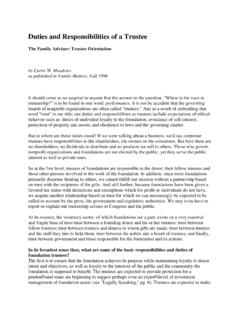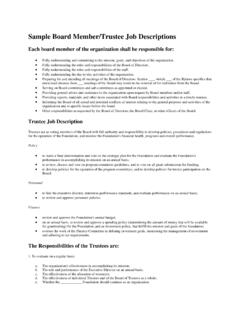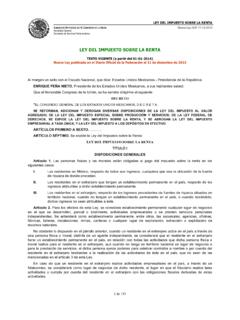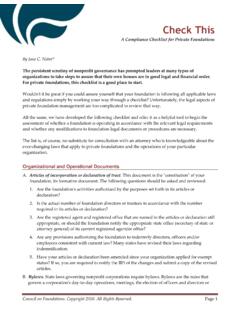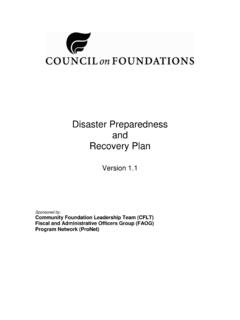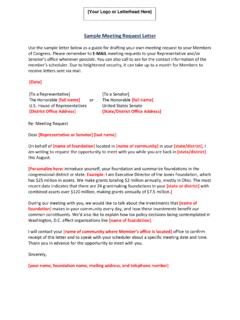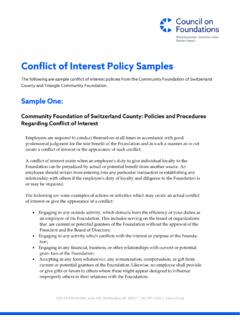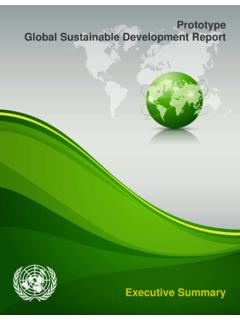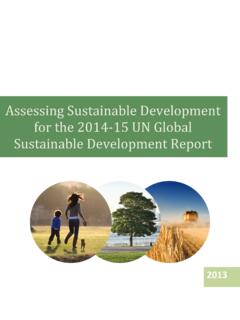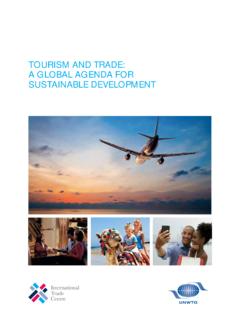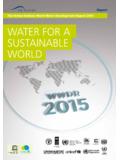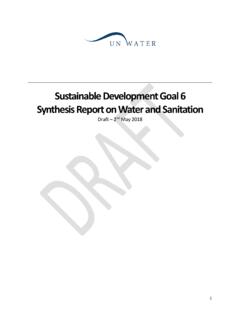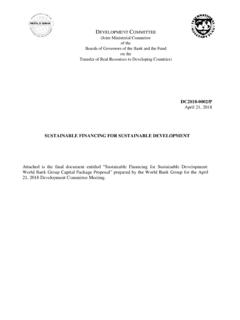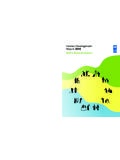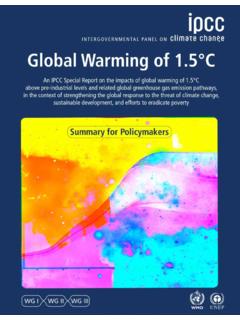Transcription of LOCAL LEADERSHIP, GLOBAL IMPACT
1 LOCAL leadership , GLOBAL IMPACT : Community Foundations and the sustainable development Goals By Natalie Ross, Council on Foundations Foreword by Vikki Spruill, Council on Foundations TABLE OF CONTENTS 2 Context for this 3 Introducing the sustainable development Goals ..4 Case Study: The GLOBAL Challenges, LOCAL Solutions Program in Poland .. 8 Case Study: Making LOCAL IMPACT through a GLOBAL Lens in Southwest Florida .. 9 Community Foundations: Acting Locally to Achieve 10 Case Study: Empowering Women and Girls in Nepal .. 12 Case Study: Ending Hunger in 12 Case Study: The SDGs for Corporate Donors .. 13 The SDGs and Community Foundations Around the World .. 14 Case Study: Vital Signs in 18 Case Study: Tracking Philanthropy s Investment in the SDGs with LOCAL Data in China .. 19 Ten Steps to Getting Started on the 20 Case Study: Learning from Abroad to Build a Culture of Health .. 22 Case Study: Philanthropy Infrastructure and SDGs .. 23 Conclusion: Convening Power + Community Knowledge = SDG 24 26 Endnotes.
2 27 1 Community foundations, no matter where in the world they are based, share a major trait: they work with partners in their communities to solve complex LOCAL problems. No two are alike. And in today s interconnected world, community foundations are critical leaders who can drive change locally in order to make progress globally. In September 2015, the United Nations unveiled the sustainable development Goals (SDGs), an ambitious roadmap for how to change our world. These 17 goals are a GLOBAL to-do-list for solving our biggest social problems, with time-bound targets that are applicable to every country in the world as we work to improve the quality of life for everyone, everywhere. While the SDGs represent a GLOBAL agenda, they require LOCAL action to achieve them. All partners from government to the private sector, civil society and philanthropy must work together to create a better future for all. Today, there are more than 1,800 community foundations operating around the world.
3 Most direct their grant dollars to support LOCAL and regional priorities, but community foundations are also important GLOBAL actors. Their work to address problems like hunger and unemployment is the same work needed to achieve the SDGs. To date, the role of community foundations in GLOBAL development has been largely overlooked. However, the ability of community foundations to be hands-on within their LOCAL communities can provide LOCAL governments and donors with the insights needed to achieve the ambitious goals within the SDGs. This report is about the relevance of the SDGs for community foundations everywhere, because we believe that these place-based, locally-led institutions are critical elements for achieving the SDGs. It s inherent in human nature to want to be part of something bigger than ourselves. The SDGs provide that framework. They give community foundations a roadmap and language for doing, and talking about, LOCAL work already in progress.
4 They are also a way to attract new funding. At the core of the SDGs is a commitment to targets and measuring progress. With 17 goals and 169 targets, the SDGs might seem overwhelming at frst but these specifc targets and metrics can make it easier for community foundations to leverage the SDGs. This is as true for a community foundation working in rural Kansas as it is for a community foundation working in urban Kenya. I am excited for you to read this report . Using the framework of the SDGs, community foundations can leverage their knowledge and expertise and make an even bigger GLOBAL IMPACT . Vikki Spruill President and CEO Council on Foundations FOREWORD The SDGs have one major aim: to leave no one behind as we build a better world by 2030. 2 Community foundations need to be brought to the table, both within individual countries and on a GLOBAL scale. While the contributions of the broader philanthropic sector are well-known in the international development realm, community foundations globally have yet to play a major role in conversations about the SDGs.
5 And many community foundations around the world are unaware of the SDGs and how they are relevant to their work. We believe community foundations are important partners for governments around the world if we are to achieve the overarching aim of the SDGs to leave no one behind. The February 2018 North American Community Foundations Summit in Mexico City introduced the SDGs to community foundations from across the continent. This frst-of-its-kind gathering connected community foundations of diferent sizes, geographies, and capacities around shared community challenges, from immigration to climate change and social inclusion. By framing shared challenges within the universal framework of the SDGs, these important grassroots actors will drive change to achieve the essence of these GLOBAL goals and improve the quality of life for all. This report is a foundational document and companion to the Summit, bridging a gap in understanding how community foundations around the world can operate through the lens of the SDGs, and showing the rest of the international development community the ways in which community foundations can play a transformational role in achieving the SDGs.
6 Connection and collaboration are key and the SDGs provide an avenue for community foundations all over the world to become more connected and to make greater collective IMPACT . CONTEXTfor this report 3 At the turn of the 21st century, world leaders gathered at the United Nations to adopt the Millennium Declaration, a joint statement of values, principles, and commitments to make globalization a positive force for all communities around the world. The need to take action was urgent. At that time, nearly half the population of people living in low-income countries lived on $ a Twenty-three percent of the world s population was More than three million people were newly infected with HIV every year. Nearly a quarter of the planet lacked access to clean, safe drinking water. As part of the Declaration, eight Millennium development Goals (MDGs) were adopted as a set of time-bound targets designed to make progress toward ending poverty, improving health and the environment, and increasing access to The MDGs marked the beginning of an unprecedented era of GLOBAL development , driving the world s most successful anti-poverty movement in history.
7 It galvanized action from the public and private sectors, and spurred major philanthropic involvement that yielded unprecedented results. While tremendous progress was made over 15 years, not all targets in the MDGs were met. In September 2015, as the era of the MDGs came to an end, the adopted the sustainable development Goals (SDGs), that build on the lessons learned from the MDGs. The SDGs are about people, planet, and prosperity and about driving development in an inclusive way that leaves no one behind. There are key diferences between the MDGs and the SDGs. The eight MDGs were criticized by many for not being inclusive enough both in the way they were decided and for the challenges they aimed to tackle. The SDGs took a whole new approach. The process of developing the SDGs was far more inclusive. The SDGs were the product of one of the largest consultation processes ever undertaken. The United Nations launched a GLOBAL survey, MyWorld2015, to understand what issues matter most, and used feedback from million people around the world to inform development of the fnal A few community foundations even partnered with the to promote the survey.
8 In Mexico, the Corporativa de Fundaciones in Guadalajara convened public and private sector partners, as well as universities, to ensure that more than 400,000 individuals in western Mexico participated in the MyWorld2015 survey. The development of the SDGs was a three-year efort by all countries in the General Assembly. The process resulted in a comprehensive set of goals and targets involving human components as well as economic development , sustainable infrastructure development , and action to combat climate change. THE sustainable development GOALS: Introducing A framework to create a better future for all. 4 The SDGs set forth a bold These goals act as a call-to-action for both the public and private sectors to help address crucial challenges such as ending poverty, ensuring access to high-quality education, and protecting national resources. 6 Emmett D. Carson, CEO & President Silicon Valley Community Foundation The GLOBAL under-fve mortality rate declined by more than half, dropping from 90 to 43 deaths per 1,000 live births billion people gained access to clean drinking water The maternal mortality rate fell by 45% The number of out-of-school children of primary school age worldwide fell by 43% MDG PROGRESS 1990-20154 5 Overall, there are 17 sustainable development Goals with 169 achievable targets.
9 These universally agreed-upon targets also ofer a revolution in the way data is used to drive international development . By having agreed-upon, time-bound targets for the SDGs, we can standardize indicators across communities and invest in data collection at national and sub-national levels. This new ability to report on progress toward the Goals creates an opportunity for transparency, as governments can report on progress in accessible ways. All of the SDGs are inextricably linked. With the right fnancing, collaboration, and coordination, each of the Goals can be achieved. A little more than two years into this new era, there is more momentum, more partnership, more accountability, and more excitement about the fact that progress toward one goal makes a positive IMPACT toward numerous others. k 64 countries have voluntarily reported their progress on the SDGs for domestic and international implementation7 k Over 9,500 companies are signatories of the GLOBAL Compact, pledging commitment to the SDGs8 k More than 65 mayors agreed to implement the SDGs in their cities9 k Dozens of collaborative projects have been tracked by the SDG Fund Private Sector Advisory Group, documenting new forms of public-private partnerships to achieve the SDGs10 k Children from 110 countries will soon learn about the SDGs from Thomas and Friends, ofered in 33 languages, as part of a new collaborative efort between the and Mattel, The current state of funding for GLOBAL development shows a stark contrast between the price tag to eliminate poverty and protect the planet by 2030, and the actual fnancial resources that are available.
10 The United Nations Conference on Trade and development (UNCTAD) estimates that achieving the SDGs will take between $5 to $7 trillion USD. The SDGs will require approximately of world GDP per year. Financial innovation whether through IMPACT investing, blending public and private fnancial instruments, or developing new types of public-private partnerships can help ensure the resources needed are available. Community foundations, and the fnancial capital at their disposal, can also help meet these fnancial targets. This time the agenda included everybody and we must work to have them achieved. We are leaving no one behind. Ellen Johnson Sirleaf President of Liberia 6 Goal 1 End poverty in all its forms everywhere. Goal 2 End hunger, achieve food security and improved nutrition, and promote sustainable agriculture. Goal 3 Ensure healthy lives and promote well-being for all at all ages. Goal 4 Ensure inclusive and equitable quality education and promote learning opportunities for all lifelong.

